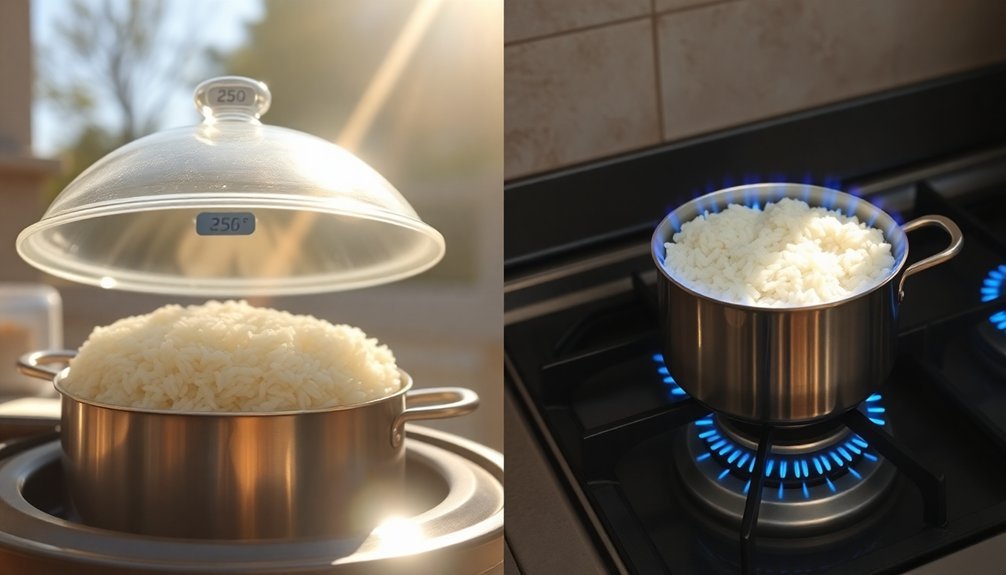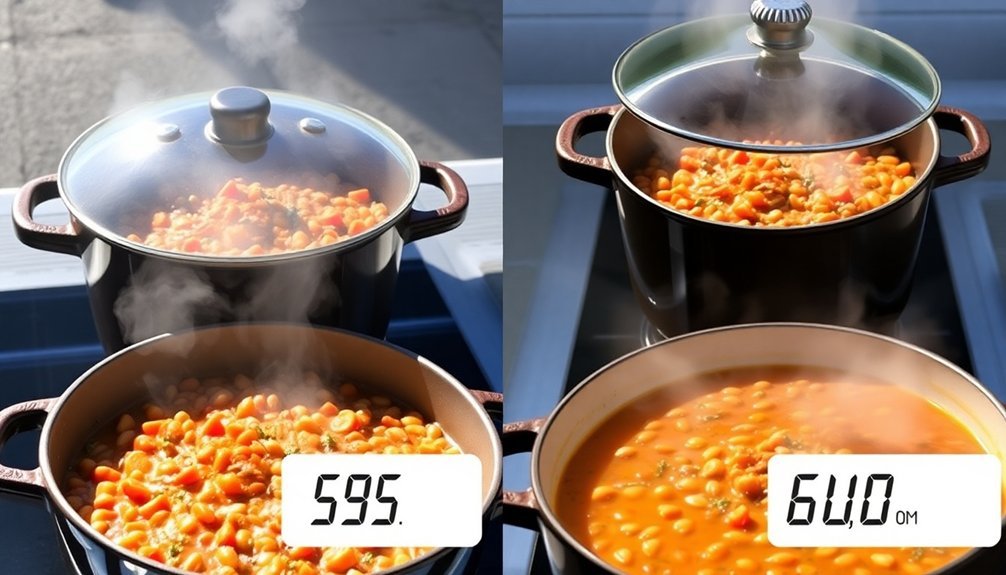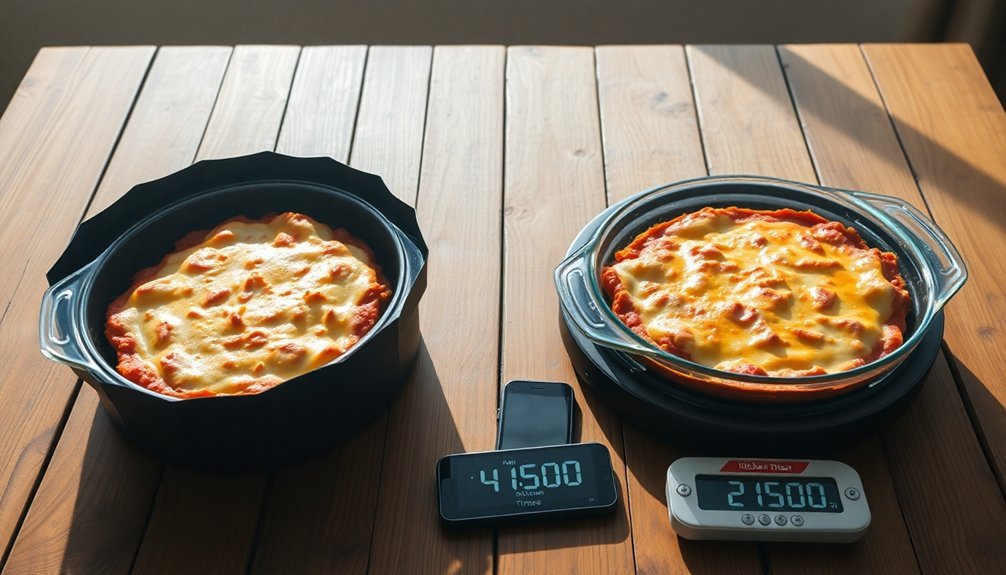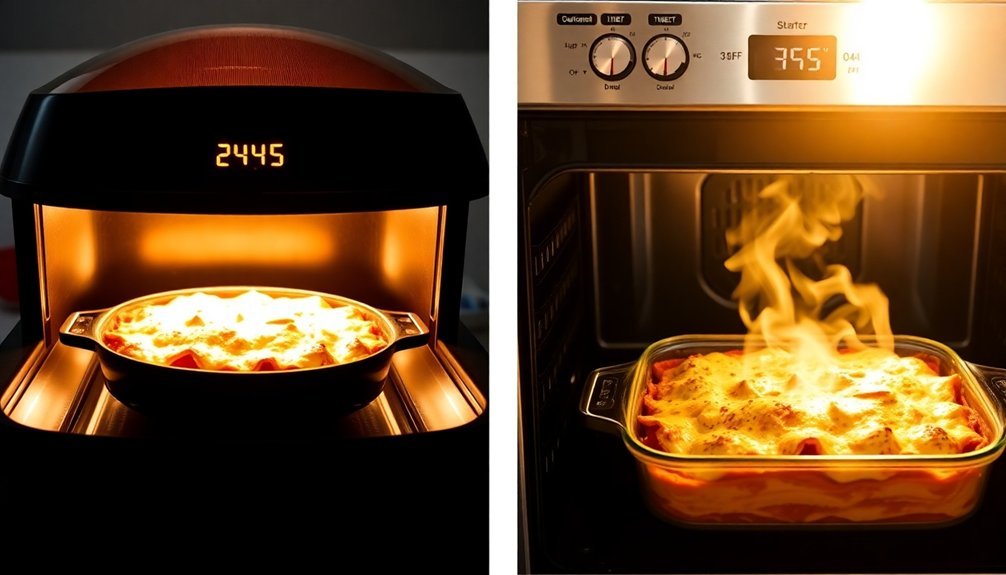When using a solar oven, you'll need to double your regular cooking times, as most dishes take 2-4 hours to cook completely. Your breakfast omelet might need 35 minutes instead of 15, while a whole chicken could require 3 hours rather than 90 minutes. You can speed up the process by cutting foods into smaller pieces and cooking between 10 AM and 2 PM when sun exposure is strongest. Weather conditions like temperature, humidity, and altitude will affect your cooking duration too. Dark or black pots with lids will help maximize your efficiency, and there's much more to learn about optimizing your solar cooking experience.
Understanding Solar Cooking Times

How long will your food take to cook in a solar oven? You'll need to take into account several key factors to get an accurate estimate. Your solar cooker's temperature, the weather conditions, and the type of food you're preparing all play significant roles in determining cooking duration.
As a general rule, you'll want to double your conventional cooking time when using a solar oven. The best results happen between 10:00 AM and 2:00 PM on sunny days. Different solar ovens reach varying maximum temperatures, with parabolic cookers able to reach over 800°F.
You can speed up the process by refocusing your oven every 30 minutes to follow the sun's movement. Using dark-colored pots and maintaining a sealed cooking environment will help maximize heat retention.
Remember that while small items like eggs might cook in under an hour, larger dishes such as whole chickens can take up to 3.5 hours.
Box Oven Temperature Ranges
Solar box ovens pack impressive heating power, reaching temperatures between 160°F and 400°F (71°C to 204°C) when properly constructed and positioned.
You'll achieve peak cooking results when your oven maintains temperatures between 300°F to 400°F (149°C to 204°C), though you can start cooking effectively at 180°F (82°C). Similar to slow oven temperatures from traditional cooking methods, these ranges are ideal for most baking needs.
To maximize your oven's temperature potential:
- Use high-quality insulation materials like cotton balls, newspapers, or packing peanuts to retain heat.
- Make certain all gaps are properly sealed and use dark-colored cookware for better heat absorption.
- Position reflectors correctly and adjust your oven's angle every 30 minutes to track the sun.
Your oven's temperature will vary based on insulation quality, design features, and sun exposure, so using a thermometer helps monitor internal temperatures accurately.
Weather Impact on Cooking

Weather plays three essential roles in determining your solar oven's cooking performance: temperature, humidity, and altitude.
When you're cooking with a solar oven, cold weather will extend your cooking time, while warmer temperatures speed up the process. Strong winds and rain can significantly affect your solar oven's performance by cooling its exterior surfaces.
You'll need to monitor humidity levels carefully – high humidity keeps surface heat trapped, leading to faster cooking, but it can also increase the risk of overcooking. In low humidity, moisture evaporates quickly, which slows down your cooking process.
If you're at a higher altitude, you'll notice that water boils at lower temperatures.
You'll need to adjust by cooking at lower temperatures for longer periods to keep your food from drying out.
Remember that elevations above 3,000 feet require recipe modifications for both temperature and timing.
Quick Solar Recipe Options
When you're looking to cook quickly with your solar oven, you'll find plenty of fast breakfast options like 25-minute open-faced omelets and 35-minute breakfast frittatas.
For meals ready within an hour, try tandoori chicken that cooks in just 30 minutes or shrimp and lemon skewers requiring only 10-20 minutes of cooking time.
Quick solar snacks include corn-on-the-cob and baked acorn squash, which provide nutritious sides without extensive preparation.
Fast Solar Breakfast Ideas
Starting your day with quick and nutritious breakfast options doesn't mean you can't harness the power of the sun. While solar ovens typically cook at 200-300°F and require double the conventional cooking time, you'll find several efficient breakfast recipes perfect for morning meals.
- Try a breakfast frittata with eggs and vegetables, ready in 45 minutes, or whip up pumpkin scones in just 25 minutes using dark, solar-safe pots.
- Speed up cooking by chopping ingredients into smaller pieces and preheating your solar oven while you prep.
- Consider an open-faced omelet that cooks in 35 minutes, or opt for pre-cooked ingredients in your breakfast casserole.
Remember to align your solar oven between 11 am and 3 pm for ideal results, and always use a thermometer to guarantee food safety.
Essential One-Hour Solar Meals
Preparing meals in a solar oven under an hour requires smart recipe selection and proper timing. While a single chocolate chip cookie takes about an hour at 250°F, you'll need to plan carefully to meet this timeframe, especially since solar cooking temperatures can fluctuate between 225°F and 300°F based on weather conditions.
For quick solar meals, you'll want to avoid complex dishes like Basque chicken, which needs 1 hour 40 minutes. Instead, focus on simple, small-portion recipes that work well with lower temperatures.
Consider adapting your regular recipes by reducing portion sizes and choosing ingredients that cook quickly. You'll get the best results by starting your cooking around noon when sunlight is strongest.
Remember that cloudy conditions will extend your cooking time, so always check the weather forecast before planning your solar menu.
Solar Snacks Under Thirty
Five delicious snacks can be ready in under 30 minutes using your solar oven, perfect for quick and eco-friendly treats. When you're craving something fast, shrimp skewers cook in just 10-20 minutes after a brief marinade with olive oil and spices.
Kale chips and s'mores are other tasty options that won't keep you waiting long.
For the best results with these quick solar snacks:
- Preheat your solar oven for at least an hour before cooking
- Choose a sunny day with clear skies, as temperatures need to reach 160-200°F
- Use dark baking sheets or aluminum foil to enhance heat absorption
Your solar oven can efficiently heat pre-cooked items like cheese roll-ups, while simple treats like s'mores come together perfectly in a pizza box solar oven setup.
Extended Cooking Time Foods

When planning to use a solar oven, you'll need to account for considerably longer cooking times compared to conventional ovens. Most dishes take 2 to 4 hours to cook, with some requiring up to 7 hours for completion.
You'll find that quick items like baked eggs and toasted coconut cook in under an hour, while cookies and muffins need 1 to 1.5 hours.
For grains, fish, and cut-up meat, plan on 2 to 2.5 hours. Whole vegetables, soups, and chicken require 3 to 3.5 hours.
The longest cooking items are dried beans, stews, and large cuts of meat, taking 4 to 7 hours.
To optimize your cooking time, use dark pots, position your oven between 10 am and 4 pm, and track the sun's movement. Remember that cloudy days will extend these times further.
Heat Efficiency and Timing
To maximize your solar oven's efficiency, you'll need to understand how it captures and maintains heat through multiple mechanisms. Your solar oven uses reflective surfaces like aluminum foil or mirrors to direct and concentrate sunlight onto the cooking surface, while insulation materials trap the heat inside.
For ideal cooking results, remember these key timing factors:
- Plan to cook between 10:00 AM and 2:00 PM when solar energy is strongest.
- Expect cooking times to be 1.5 to 3 times longer than conventional ovens.
- Use dark, heat-absorbing cookware to reach temperatures between 150°-300°F faster.
You'll achieve the best results on clear, sunny days when your reflectors are properly positioned and your insulation is well-layered.
Some foods cook relatively quickly – bacon in 30 minutes, while others like tandoori chicken need about 1.5 hours.
Food Quantity Time Adjustments

Understanding food quantity is essential for accurate solar cooking times. When you're planning your meals, remember that larger portions require considerably more cooking time than smaller ones.
You'll find that whole vegetables and large cuts of meat like turkey can take 4-7 hours, while smaller items like eggs and toasted coconut cook in under an hour.
To reduce cooking time, cut larger foods into smaller pieces. Fish and cut-up meats typically need 2-2.5 hours, while grains and cereals fall within the same timeframe.
If you're baking, expect cookies and quick breads to take 1-1.5 hours. For dishes like dried beans and stew, plan for 4-7 hours of cooking time.
Smaller portions of baked goods like muffins and brownies will cook faster than their larger counterparts.
Timing Tips for Success
Successful solar cooking relies heavily on proper timing and environmental awareness. You'll want to plan your cooking between 10:00 and 2:00 when the sun's rays are strongest, and choose a wind-protected location to maintain consistent temperatures.
Keep these critical timing elements in mind:
- Check your solar oven's position every 20-45 minutes, adjusting it to follow the sun's movement for ideal heat retention.
- Plan for cooking times that are 1.5 to 3 times longer than conventional methods, especially for larger dishes.
- Factor in your local climate and season, as cloudy conditions or winter months will require additional cooking time.
Remember to use dark cookware and avoid aluminum foil, as these choices greatly impact your cooking efficiency and overall success.
Equipment Selection and Duration

Your choice of cooking container directly impacts how quickly and effectively your solar oven will perform, with metal and clear glass vessels offering the best heat transfer properties.
When comparing different solar oven models, parabolic reflectors typically heat up fastest and reach the highest temperatures, while box cookers provide more consistent, though slower, cooking times.
You'll get better results with dark or black-colored pots that absorb heat well, especially when paired with appropriate reflective surfaces to maximize solar energy capture.
Pot Types and Performance
Three key factors determine the efficiency of your solar oven: pot type, material, and size.
You'll get the best results using dark-colored or black metal pots since they absorb more sunlight and retain heat effectively. While glass containers work, they'll extend your cooking time greatly.
To maximize your solar cooking performance:
- Choose a pot that's slightly shorter than your inner box, allowing proper heat circulation while fitting snugly within the dimensions.
- Always use lids or covers to maintain consistent temperature and reduce cooking time.
- Select appropriately sized containers for your food quantity – overly large pots waste energy while too-small ones risk overcooking.
Remember to adjust your oven's position frequently to track the sun's movement, as this markedly impacts your pot's heating efficiency and overall cooking time.
Efficiency Between Cooker Models
While different solar cooker models share basic principles, their efficiency and cooking times vary greatly based on design and construction. You'll find that commercial models like the All American Sun Oven heat up quickly, reaching 350°-400°F in just 30-45 minutes. In contrast, simple box cookers and panel cookers take longer but remain effective for slow-cooking meals.
| Model Type | Cooking Efficiency |
|---|---|
| All American Sun Oven | Heats to 400°F in 30-45 min |
| Box Cookers | Handles one large pot, feeds 6 |
| Panel Cookers (CooKits) | Best for slow cooking |
| Commercial Models | Most efficient, precise temp control |
Your choice of cooker affects cooking duration greatly. While panel cookers excel at slow-cooking meals throughout the day, commercial models offer quicker cooking times and more consistent results through better insulation and reflective materials.
Frequently Asked Questions
Can I Leave My Solar Oven Unattended While Cooking?
You shouldn't leave your solar oven unattended except during summer's peak hours. You'll need to make regular adjustments throughout the day to track the sun and guarantee ideal cooking temperatures, especially in winter.
How Do Different Pot Materials Affect Cooking Times in Solar Ovens?
You'll cook fastest with dark-colored pots, especially black cast iron or dark metal pans. They absorb and retain heat better than light-colored cookware. Avoid aluminum foil or reflective materials that'll increase cooking times.
Does Altitude Impact Solar Cooking Time and Temperature?
Yes, at higher altitudes you'll experience faster cooking times and higher temperatures in your solar oven. There's less atmospheric interference, allowing more direct sunlight to reach your cooker and heat food more efficiently.
Can I Use Aluminum Foil to Speed up Solar Cooking Time?
Yes, you can use aluminum foil to speed up solar cooking. It'll reflect more sunlight onto your food and increase temperature inside the oven. Just remember to smooth it well and replace it when it loses reflectivity.
What's the Minimum Sun Exposure Needed for Effective Solar Cooking?
You'll need at least 3-4 hours of direct sunlight between 10 a.m. and 4 p.m. for effective solar cooking. It works best when the UV index is 7 or higher with unobstructed sun exposure.
In Summary
You'll find solar cooking generally takes 1.5-2 times longer than conventional methods, but the extra time is worth the energy savings and eco-friendly benefits. Keep tracking your cooking times and adjust based on weather conditions, food quantity, and oven design. With practice, you'll develop an instinct for timing your solar meals perfectly. Remember to start early on cloudy days and always use a food thermometer.





Leave a Reply